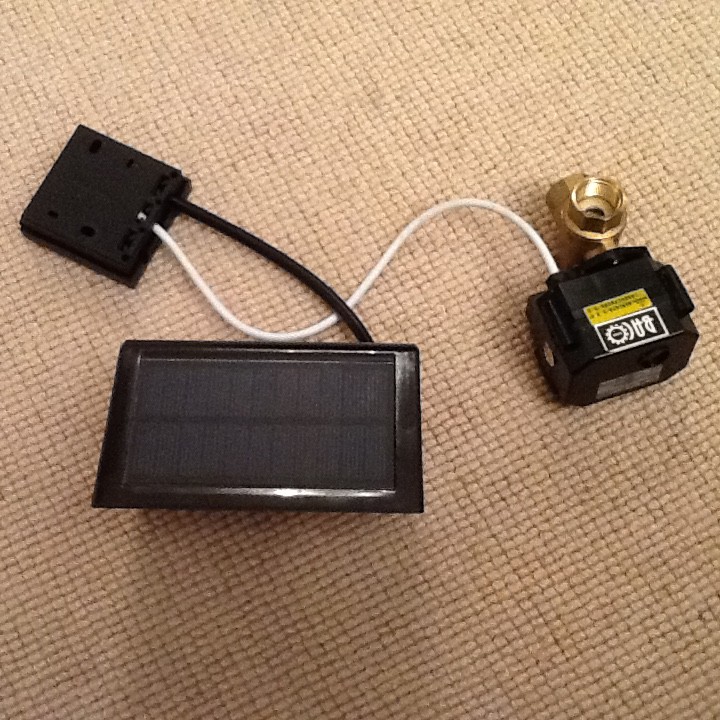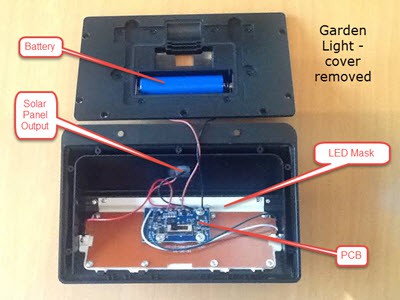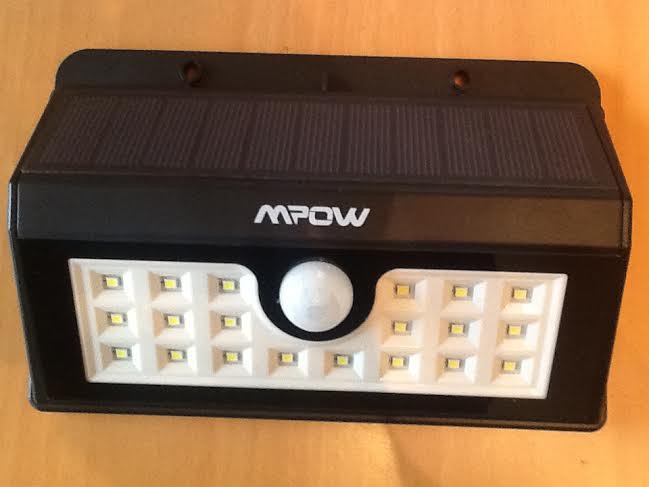-
Progress on the Overall Assembly
08/27/2016 at 20:00 • 0 comments- For some time I've been considering how best to construct the Overall Assembly of the equipment that forms the Zone Controller' I.e. that required at each, in my case Raised Bed, to control the Irrigation. Those following the Project will have noticed that I've adopted a new housing (still based on a readily available Garden Lamp) that provides a waterproof container with integral Solar Panel, Battery and three small switches for Reset, Boot and Manual Override respectively. The original Control Electronics have been removed as has the LED Lamp Asembly.
![]()
The hole vacated by the Light Sensor is now used for a waterproof grommet for a cable to the Solenoid and the Soil Sensor with a small junction box being used to split the single cable into the 5 cores to the Solenoid and 3 cores to the Sensor (not fitted at time of photo)
Jelly filled 3M connectors are used within the junction box. Water and corrosion are enemies in outdoor installations. A new Custom Designed PCB will be fitted on the same mountings as the original LED Lamp PCB although the many protrusions from the back cover, notably the battery holder, makes PCB layout a complicated task which is yet to be completed. Although changing to an ESP8266-12 will facilitate Over the Air (OTA) updates, space has been found for an FTDI port accessible when the back cover is removed. Layout sketch to follow in next post.
-
Further changes
08/22/2016 at 20:29 • 0 commentsThose of you who have been following the Project will see from the latest Gallery Pictures that there has been a number of changes since the Concept Stage not the least of which is the switch to a different Housing This needs a revised layout of the PCB to fit the smaller space available. At the same time, having learnt from experience with the prototype there hs been some design changes. These will, hopefully, facilitate use of the excellent work done by Peter Scargill (www.tech.scargill.net) on producing binary code for the ESP8266 that appears to admirably fit the Requirement. Meanwhile good progress has been made on mounting the Solenoids and running the buried feed pipes.
-
Change of course ....
07/31/2016 at 20:28 • 0 commentsIt's sometime since I added a log entry and during this period I have given some thought as to how to approach the next stage of the contest 'Automation'. I didn't consider the previous stage 'Citizen Scientist'. The month gap have me time to consider the way ahead and to fit in major surgery (heart valve replacement) and some recuperation time. As a result of having a period of reflection I have decided to :
- Enlarge the scope of the Project by expanding the original basic system to cater for all my Raised Beds
- Change the software architecture to utilise Node-Red
- Adopt a different housing, still a modified Garden Lamp but one in which the PCB mounting will be more easily accomplished
- Bury the Irrigation Pipe to reduce the risk of tripping over external tubing (trenches were dug for me by friend, I couldn't have managed it).
- Ensure that the Solenoid Assemblies (Valve, Solar Panel, Junction Box) are easily removed for over-wintering whilst remaining waterproof whilst in position.
So now I have to press ahead with the new PCB layout and continue work on the firmware that will be built around the excellent work from Peter Scargill (www.tech.scargill.net) and his colleagues.
-
Firmware alternatives.... difficult decisions "
06/12/2016 at 20:12 • 0 commentsHaving completed the 'Design Your Concept' stage and received a small amount of , although very welcome, 'seed money' thoughts have turned to the Subsequent Stages and into which Catergory or Categories my Project might fit. Neither the 'Anything Goes' or the 'Citizen Scientist' Challenges would appear to be relevant and so further consideration will be given to either or both of Challenge 4 'Automation' and Challenge 5 'Assistive Technologies' . Fortunately for me this gives a little breathing space particularly as deciding on a suitable communication protocol and the optimum Software Development Environment/Language is proving to be a time consuming challenge.
Decisions are now close and currently I'm conducting tests using MQTT with a RaspberyPi as a 'Broker' and the target ESP8266 Solenoid Controllers as Clients/Servers. Once I have concluded these tests I shall look at redesigning the original PCB to conform t a modified form factor to fit my selected housing.
-
So onto the next Stage
04/30/2016 at 22:05 • 0 commentsWork continues on testing the PCB. Using a Hot Plate to solder the SMD components has been rather more difficult than I'd anticipated and only after three unsuccessful attempts have I got a working prototype. Getting the correct amount of paste on the pads and controlling the temperature profile with long reaction times to changes of temperature settings being the most problematic aspects. Maybe I should have invested in a Solder Reflow Oven but it's all part of the 'learning new skills' process.
I have not yet attempted to drive the Solenoid and still have to decide between the 12 volt Bacor with its position feedback and the 9V Claber as both have their advantages and disadvantages. Also on the 'list to do' is the revised layout of the PCB to adopt the necessary profile for the proposed modified Garden Lamp housing.
It's going to be a busy couple of months.
-
Is this the solution to the Waterproofing?
04/25/2016 at 14:42 • 0 commentsI have taken delivery of a couple of Larden Lamps. Both looked well contructed and had a 5 volt Solar Panel, a PCB with LEDs ans a 3.7V battery. Seemed a pity to canninalise one of them however I can use the other for its original purpose. The photos show the selected Unit and the constituent parts. Would you believe it the opening for the Infra-red Movement Sensor seems to be just right for my waterproof connector to he Solenoid. Th original PCB will be replaced by my design although a degree of redesin will be necessary to accommodate the revised form faactot and add an interface, maybe I2C to input Moisture and Temperature of the relevant Raised Bed. Then it'll be onward and upwards towards the complete syste.
Watch this space!
![]()
![]()
-
When is a Garden Lamp not a Garden Lamp ?
04/22/2016 at 15:45 • 0 comments- This morning I took delivery of a Garden Lamp, one of many widely available on eBay, from Amazon and other sources. It attracted my interest because it had (1) a Solar Panel (2) a 3.7V Lithium Battery and (3) most importantly a Waterproof Housing. What else would you want to house the electronics for my Project. A quick inspection of the innards revealed that it certainly had potential and now I need to determine how best to use it. Having looked at its construction my intention is to remove the existing PCB and the LED light panel and replace them wiry the Solenoid Control PCB. the Sensor Movement Device would be removed (it's soldered into the PCB) as its function would no longer be necessary. An added bonus is that the hole left by the Sensor looks just about the right dimension I need for the watertight connector for the cable to the Solenoid. I'll insert some photos in the next log
-
A start on the Firmware
04/18/2016 at 09:44 • 0 commentsThe Irrigation System is envisaged to comprise a number of the Zone Controllers connected via a wireless network with a Central Control Unit. Wireless control of the functions requires firmware in the ESP8266. Powerful as it is this incredible device does have limitations on usable aMemory space and processing power. These limitations effectively rule out the use of Interpreter languages such as Basic or Lua so most of my weekend was spent setting up the Arduino ESP8266 Software Development Environment (SDK) to allow me to program in C+ + and generate more efficient binary files for the firmware.
-
Thoughts on the Mechanics
04/14/2016 at 20:15 • 0 commentsWhilst I wait for some small components to come by post my thoughts have turned to the physical implementation in terms of housing, mounting and waterproofing. Not being particularly adept at metalwork and lacking tools other than a basic drill and a few other everyday items such as small files etc., I'm very keen to adapt what is already available rather than constructing anything from scratch.
With this in mind I am looking at the abundance of Garden Lights available on eBay and from other sources. Many are waterproof and include a solar panel and battery. The intention would be to ditch the LED lights and Movement Sensor and just use the housing, solar panel and battery providing that there is sufficient space to house my PCB. I've sent for what looks a suitable candidate. I hope it meets my expectations.
-
Time for testing
04/11/2016 at 10:42 • 0 commentsThe Hotplate soldering has been achieved although not without burning a couple of boards until I got the hang of getting a way to implement a crude flow profile using the hot plate heat adjustment. An infra red digital temperature meter proved to be an essential aid to temperature control.
The assembled PCB is now being tested. One or two changes required but, much to my surprise, the Boost Convterter worked without any changes. The Solar charge controller seems to be functioning although at the moment it is operating from a USB supply and not a Solar Panel. The ESP8266 isn't yet working, it doesn't seem to boot correctly even though all the conditions seem to be as expected. I have used many of devices in the past year or so without problem so I guess it's just a faulty device or I have made a stupid mistake somewhere.
I've decided that on the next version I'll add some LEDs to give me more visual clues of the status.
Meanwhile I have been investigating cost effective ways of housing the board. One promising possibility is to modify a waterproof outdo solar wall light and I have sent for one that seems to have a 5 volt Solar Panel and a rechargeable Ni-Cad battery together with mounting hardware. Why does it take so long to get stuff from China
Solar Powered Garden Irrigation System
Minimal effort Solar powered wireless controlled automatic watering
 Michael Frank Taylor
Michael Frank Taylor

